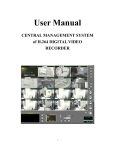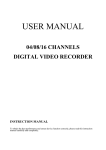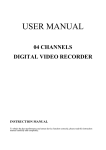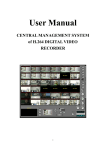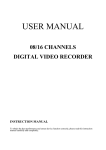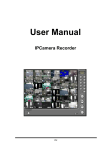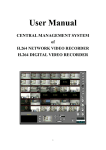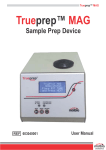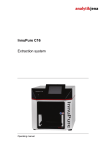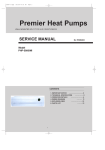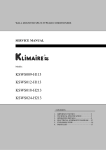Download CMS User Manual
Transcript
User Manual CENTRAL MANAGEMENT SYSTEM of H.264 DIGITAL VIDEO RECORDER 1 TABLE of CONTENTS I. SYSTEM REQUIREMENTS .............................................................................3 A. MINIMUM REQUIREMENTS..................................................................3 B. SUGGESTED REQUIREMENTS .............................................................3 II. CENTRAL MANAGEMENT SYSTEM SETUP .............................................6 A. DVR SETUP .................................................................................................6 B. GROUP SETUP............................................................................................8 B. GROUP SETUP............................................................................................8 C. SCHEDULE SETUP..................................................................................12 D. SYSTEM SETUP .......................................................................................14 III. REAL-TIME MONITOR ...............................................................................15 A. REAL-TIME IMAGE................................................................................15 B. BUTTON INSTRUCTION of REAL-TIME IMAGE ............................16 IV. EMERGEMCY RECORD & DATA BACKUP ..............................................18 A. EMERGENCY RECORD .........................................................................18 B. DATA BACKUP .........................................................................................21 V. VIDEO PLAYBACK .........................................................................................23 A. VIDEO PLAYBACK..................................................................................23 B. EXPERT IMAGE.......................................................................................31 B. EXPERT IMAGE.......................................................................................31 VI. DIGITAL ZOOM...............................................................................................32 APPENDIX A: GRAPHIC CARD TEST TABLE ..................................................33 2 PREFACE DVR Central Management System (CMS) is a 16 views recording software which specific supports our H.264 DVR (Digital Video Recorder). This software can provide real-time monitor, record the video on PC and then playback the recorded video to the user. Moreover, the user can also setup the software recording method for the specific circumstances and performs video playback via Time and Event Search. I. SYSTEM REQUIREMENTS A. MINIMUM REQUIREMENTS i. ii. iii. iv. CPU: Intel Pentium 4 2.0G Memory: 512MB VGA card: 128MB Monitor Resolution: 1280 x 1024, 1024 x 768 (This user manual is made by 1280 x 1024 resolution.) v. OS: Windows XP / 2000 B. SUGGESTED REQUIREMENTS i. ii. iii. iv. v. CPU: Intel Pentium D 3.2G or higher Memory: 1024MB or higher VGA card: 256MB or higher ( ATI chipset suggested) Monitor Resolution: 1280 x 1024, 1024 x 768. OS: Windows XP / 2000 3 II. Program Install and Uninstall A. Program Install i. To install CMS SOFTWARE, please double click ii. License Agreement. Select “I Agree”, Go to the next step. iii. Select the directory for CMS SOFTWARE. The default directory is "C:\Program Files\CMS Software ". Select “Next”. iv. . Set up the name of the program folder. The default is “ CMS Software ”. Click “Install” to start the installation. 4 v. When finish, click “Close” to close the procedure of the installation. vi. To start the program, select “Start” Æ”Program”Æ””CMS Software ”Æ”CMS Software”. B. Uninstall i. To uninstall the program, select “Start” Æ ”Program” Æ”CMS Software”Æ ”Uninstall” to remove the program. 5 II. CENTRAL MANAGEMENT SYSTEM SETUP Please setup Central Management System step by step according to the following instructions. NOTE: Select “Start” Æ ”Program” Æ”CMS Software”Æ ”CMS Software” to operate CMS software. A. DVR SETUP i. Click button to enter administrator page, and select tag. ii. Among DVR Setup page, click button to add DVR, and then fill in the information about the DVR(s) which is going to connect. iii. After finish adding DVR(s), DVR LIST block will display the new DVR(s) which just add. iv. After complete the above setting, click button to perform the connection. If it is success for connection, the screen will pop-up the success information dialog box. (However, if it is failure for connection, 6 the screen will pop-up the failure information dialog box.) NOTE: If the user wants to delete the connected DVR, select the DVR first and then click v. button to delete the DVR. If the connected camera within the DVR List includes PTZ function, PTZ preset point can be setup via operating PTZ block. The operating steps are presented in the following, a. Spread up the DVR within the DVR List, double-click the camera which includes PTZ function. b. Click the drop down list of preset point and change the name of it. c. Then, use the navigation key to adjust the preset point position. d. Finally, click the preset point button to complete the setting. 7 B. GROUP SETUP i. Click button to enter administrator page, and select tag. ii. Within Group Setup page, right click of the mouse on the Group List and select Add Group option. The new add Group 1 will display under the Group List. iii. Right-click the button of the mouse and select Add Area option. The New Added “Area 1” will display within Group 1. iv. Click Area 1 to expand this area. (NOTE: Each area can display 16 views.) v. Finally, add the DVR channel into the new created Area. There are “Mouse Drag”, “View All” and “Individual Select” three methods. 8 a. Mouse Drag a-1. Select the DVR channel which is going to add into the Area View. a-2. Drag the mouse from the selected channel to the Area view. As the following example, b. View All b-1. Select the Area first and then right-click the button of the mouse on the DVR. After that, select View All option. b-2. Click the Area which is mentioned above and it will display all 16CH of DVR. 9 c. Individual Select c-1. Click DVR to expand all the DVR channels。 c-2. Right click the button of the mouse to select the channel which is going to add to the Area, and select the display view of the Area. c-3. After complete the selection, the Area view will display the DVR channel which just mentioned above. 10 v. If the user wants the Area View only display I Frame, the user can click the View No. within the I Frame Only block to adjust the Real-Time display. (NOTE: Only display I Frame can increase the PC efficiency.) 11 C. SCHEDULE SETUP i. Click button enter to administrator page and then click tag. ii. Select the record path when operate Emergency record and Synchronization record. Moreover, click “Use Overlay” to decide to use overlay play mode or not (NOTE: Click “Use Overlay” can increase PC efficiency.). iii. Moreover, within system setup, the user can setup the time schedule of Sync Record as well. The setting steps are shown in the following, a. Regularly Sync Record Time Schedule Setup a-1. Select the Sync Record DVR from the drop down list. a-2. Left-click the button of the mouse and pull the time range which is performed the Sync Record. 12 a-3. Click button to finish the time schedule setup. As the following image, (NOTE: Click the setup.) b. button to cancel Special-Time Sync Record Setup b-1. Select the Sync Record DVR from the drop down list. b-2. Select the Start and End Time of the DVR. b-3. Click button to finish special-time setup. As the following image, iv. After complete the setup, please click setting and press button to save the to exit Schedule Setup page. 13 D. SYSTEM SETUP i. Click button enter to administrator page and then click tag. ii. After entry to the system setup page, the “Use Overlay” and “Auto Adjust Resolution” two options are provided. a. b. Use Overlay: Select “Use Overlay” can increase PC efficiency. Auto Adjust Resolution: Select “Auto Adjust Resolution” can alter the screen resolution automatically. (NOTE: if the PC screen supports 1280*1024 resolution, the screen will adjust to 1280*1024 and CMS software will adjust to 1280*1024 screen resolution automatically after “Auto Adjust Resolution” is selected. However, if the PC screen does not support 1280*1024, the screen will adjust to 1024*768 and CMS software screen will adjust to 1024*768 resolution automatically.) c. iii. Default Screen Split: The number of split screen which will display when CMS software is operated in the beginning. After complete the setup, please click and press to exit System Setup page. 14 button to save the setting III. REAL-TIME MONITOR A. REAL-TIME IMAGE DVR Central Management System (CMS) is software which can control Multi-DVRs. Due to CMS is designed by “Group” concept, the software can combine different channels within different DVRs into ONE Group to perform real-time monitor. The image is shown in the following: 15 B. BUTTON INSTRUCTION of REAL-TIME IMAGE i. ii. : When connected DVR has triggered events, these triggered events will be presented within this block. : Double-click the left button of the mouse on the triggered event of the Event List block, the live image will be transferred into the playback mode of this event. Click on this button back to the Live Image mode. iii. : System Log. Press this button can display the software system log which is including CMS start and close time and so on. The system log example is shown as follows, 16 iv. : When click on the view, the digital zoom panel will be displayed to control the digital zoom in/out. v. : Snapshot. Select the view first and then click on this button to save the view image. vi. : PTZ controller interface. Provides Focus、 Zoom and IRIS. vii. : Emergency Record Status Light. viii. : Close the program. ix. : Get into administrator page. x. : Recorded video playback xi. : Emergency REC.。Click this button to start recording immediately in emergency situation. To stop recording, please click the button again. : Download the file. Click this button to download the xii. specific time period file within the Group. After finish selecting the Start and End Time, please click button to start download xiii. / : Minimize the program / Full Screen mode。 Minimize the program to the windows toolbar. / To exit the full screen mode, use “Esc” or right-click the mouse. xiv. / / / Split Screen : This software can display Max. 16 views. Press these four buttons to switch 16 views , 9 views , 4 views 17 and 1 view 。 IV. EMERGEMCY RECORD & DATA BACKUP button to enter Emergency Record mode. Moreover, click Click button to perform data backup. The operating instruction is shown in the following. A. EMERGENCY RECORD 18 i. Before operate Emergency Record, please click button to enter administrator page. ii. Then, select As the following image, iii. Click on the drop down list of 1. Record Path block to select the HDD to save the Emergency Record file. After that, click on 2. tag to enter to schedule setup page. button to save the setting. Finally, click on 3. button to exit System Setup page. 19 1. 2. 3. iv. Under the Real-Time Image mode, please click button to start Emergency Record. NOTE: This Emergency Record is for GROUP view recording. When start recording, the will become red. If the Emergency Record does not stop by the user, the system default for recording time of Emergency Rec. is 5 Minutes. 20 B. DATA BACKUP The Data Backup of DVR Central Management System is to backup the data from the connected DVR(s). i. Under the Real-Time Image mode, please click enter Download page. button to ii. Click DVR drop down list to select the backup DVR and then, it will display the DVR recorded time period on its right hand side. iii. Select the Start and End backup time. 21 iv. Click button to select data saved folder and then click to start backup. NOTE: 1. If the user wants to stop backup immediately during the backup period, please click button to stop it. 2. Each backup file will be named as START TIME. For example: (20080630154009.264) 3. Click “Backup R6Viewer” option can download R6 Viewer software. 4. The downloaded *.264 file has to be played by CMS software and R6 Viewer software. It has not supported by other media player. 22 V. VIDEO PLAYBACK Please click to enter Video Playback mode. A. VIDEO PLAYBACK Please select the Video Playback mode. There are DVR Search, Download File and Emergency Rec. three playback modes. For the following image, 23 i. DVR Search a. Under the DVR Search playback mode, move the mouse to the right of the screen. SEARCH TOOL will pop-up. For the following example, b. Select the DVR first, then it will display the recording time of the selected DVR. 24 c. After selected the playback DVR, video playback will be operated by doing Event Search and Time Search. c-1. Event Search c-1-1. Select the playback HDD of DVR . c-1-2. After selected the HDD, it will display all trigger events to the following table. Double-click the left button of the mouse on the trigger event. For the following example, c-1-3. After finish the above setting, the playback screen will play the selected event video. c-2. Time Search c-2-1. Please select the playback start time within the Time Search block. c-2-2. After finish the time setting, please click button to start video playback. d. Click / / / button to switch the playback split screen 1 CH/ 4CH/ 9CH/ 16CH. e. Click to stop playback. Moreover, click to start playback. f. Use & to fasten the forward and rewind playback speed.(NOTE: Forward and Rewind playback only display I Frame.) 25 ii. Download File a. Select Download File option within Select Mode block. Then, click b. button to open the playback file. Select the file first and then click Open button to start playback. 26 c. Within the playback image, the user can use the seeking bar which is under the playback screen to find out the specific time-point. As the following example, 27 iii. Emergency Rec. a. Select Emergency Rec. option within Select Mode block. The Record List block will pop-up on the left of the Select Mode block. b. Select the HDD which saved the Emergency Record file, and then double-click the left button of the mouse on the Emergency Record file which wants to playback. 28 iv. Sync Record a. Select Sync Record option within Select Mode block. The Record Index block will pop-up. b. After selected the hard disk, the drop down list will display the DVR(s) which has reserved the data of Sync Record. c. After selected the DVR, it will display the date which possesses the data of Sync Record. As the following image, clicking the different date will present the correspondence Sync Record time 29 period. (NOTE: The time period will become red while having Sync Record data.) d. Finally, double-click the left button of the mouse on the red time period to perform the video playback. 30 B. EXPERT IMAGE Image data can be export as JPG or AVI format. i. ii. Export as JPEG format: a. Click button. It will show the following dialogue box. b. The default filename will be named as “Img_channel_ yyyymmdd_hhmmss.jpg” format. The user can decide the filename and the saving path. Export as AVI format: a. Click button. It will show the following dialogue box. b. The default filename will be named as “AVI_ yyyymmdd_hhmmss.avi” format. The user can decide the filename and the saving path. 31 VI. DIGITAL ZOOM By enabling the digital zoom function, user can zoom in/out the image to get proper view. Digital zoom can be functionalized in live-viewing, playback viewing. The following figures refer to the digital zoom panel. There are three main components of digital zoom panel. i. :Preview window. The image or video in the preview window is not live, the image frame will be updated within a time interval. The red frame indicates the live-viewing window, and the number of the left-down corner indicates the zooming rate. ii. :Digital zooming bar. By moving the control bar up or down, the live-viewing and preview window will be zoomed in or out. The zoom rate is from 100% to 1000%. iii. :Zoom status. By un-check this function, the image or video will be displayed in the original size. 32 APPENDIX A: GRAPHIC CARD TEST TABLE The following list presents the graphic cards which have been tested with Network Recording Software Premium series. OS Windows 2000 ATI NVIDIA GEFORCE 6200 ATI RADEON 9200, RADEON 9550, RADEON XPRESS 200 NVIDIA GEFORCE 6200, GEFORCE 6600, GEFORCE 7100, GEFORCE 7300, GEFORCE 8500 ATI RADEON XPRESS 200M, RADEON HD 2400 PRO Windows XP Windows Vista RADEON 7500 NVIDIA GEFORCE 8500 Intel G33 NOTE 1: All the graphic cards which are shown in above table have to update their driver to the latest version. Please go to ATI, NVIDIA or Intel official website to update the driver. NOTE 2: By using Windows Vista, due to Intel G33 Driver (Version: 7.14.10.1461) from its OEM have not supported Vista DirectX 10 yet, it cannot display the image within Overlay mode while operating Dual-Monitor. Therefore, this caused problem still wait for the solution from its OEM. 33


































